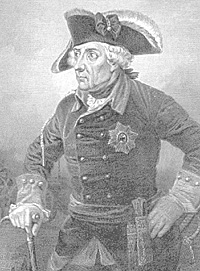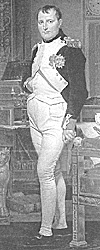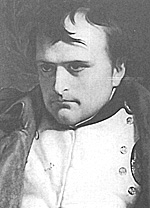From Frederick the Great to Napoleon
Was There Anything in Between?
by Roland Kessinger, Germany
| |
Not only had the Austrian and French armies begun their post-Seven Years War overhaul, but Frederick himself in his later years had started the reform of the Prussian army by introducing new concepts, which changed classical linear tactics. Beyond the military world, the philosophical approach of the Enlightenment had filtered through into a rethinking of tactical maxims in the last third of the 18th century. At the same time, between 1752 and 1802, all the major nations (including the USA) opened their military schools for the formal training of officers, based on a mix of the military lessons of the 18th century and the teaching of new concepts.
The origins of linear tactics date back to the days of the Dutch army reform under Maurice of Nassau, later perfected by the Swedes under Gustavus II. Adolphus during the Thirty Years War. The linear system would then reach its zenith from the second half of the 17th century to the mid-18th century, particularly after the Prussians introduced the cadenced step and more formalised drill.
At the same time, permanent standing armies under the direct control of the sovereign were created and perfected to replace the older mercenary formations assembled mostly only in time of war. Uniforms demonstrated the status of the soldiers as servants of their sovereign and drill created a “uniform” approach to military training of the lowest soldier.
This era, known by the architectural term, Baroque, was dominated by a general fascination with geometry, as the great mathematicians, such as Newton and Leibnitz developed their mechanistic theories. Gardens, fortresses (notably Vauban’s) and towns were constructed using geometric principles on a grand scale – not surprisingly, this mechanistic approach permeated all areas of philosophy and the development of the ideas and models for interpreting the world. The mechanistic way of thinking viewed the whole world as a machine where all parts worked together like the cogwheels of a clock. It was this model, which also influenced the military thinkers, especially in the drill regulations, which began to appear in the 1730s. According to the standards of the Baroque age, soldiers had to move like human machines. Battalions had to interact with other units, just like the cogs of a machine. Even whole campaigns were planned along the lines of geometry on a base like movements on a chessboard.
However, the Enlightenment, which spread across Europe during the last third of the 18th century swept away the old mechanistic models and replaced them with a much more natural rationale, based on each component thinking and acting for itself. The philosophers of this period saw special natural and independent forces at work in every organism from small creatures to whole nations. Even in art, the standardised Baroque was soon replaced by the more stylish and much less formal Rococo.
Strangely, military historians have largely ignored the impact of the late 18th century Enlightenment/Rococo age and seen the Age of Reason as a period of decline following the rigid mechanism of the Baroque. Tacticians and strategists of this age are presented as deploying their armies and battalions like parts of an overcomplicated machine in an absurd dance designed to avoid actual confrontation. Only the French Revolution and later Napoleon, so many recent authors claim, created something new and revolutionary in warfare, which overwhelmed the armies and their designers, whose strategic and tactical concepts had dominated the Rococo period.
This interpretation is actually based on a selective view of events and a concentration on the single greatest personality of the period. In fact, as the academies were set up and armies developed as professional forces, there were many fascinating developments in the last third of the 18th century right across Europe before the French Revolution even began.
The new natural picture of the world had consequences for the military sector, too. For example, the drill manuals of the late 18th century [1] no longer prescribed mechanical movements to load a musket,
as more natural movements now had to be learned by the recruits. At the tactical level, the pure geometrical concept of linear tactics was aban-doned - the line remained the basic formation on the battlefield, but the closed-up lines were augmented and protected by light troops long before the French Revolution. Consequently, social revolution was not a prereq-uisite for a further significant development in warfare. Linear tactics in its most extreme geometric style had long been given up - the French Revolution simply opened up completely new ways for recruitment and created the first truly mass national army. In terms of higher level organisation, the French had experimented with permanent divisions long before 1789. In the 1780s, they combined light and line regiments into permanent units. In the new military colleges, the leading thinkers were already debating the merits of line and column within the Royal French army. Thus, most of the tactical “innovations” of the post-1792 period had their origins in the former period. Little new was added later – Napoleon did not introduce much tactical change (the carree d’Egypt had its origins in formations used by the Austrians and Russians against the same enemy - the Turks - in the 18th century).
Another supposed change introduced by the Revolutionary armies was the speed of movement, which was made possible by the complete abandonment of logistical support. Although born out of ecessity, since the bankrupt state could not supply its soldiers, there is no real evidence during the campaigns of 1796 or 1799/1800 in Germany that living off the land made the French more mobile – it was as in 1805 essentially a question of who was marching on the main roads. On the other hand, it is well documented that the French soldiers were suffering from hunger and were wretchedly equipped. There doesn’t even appear to be a proper investigation into the consequences of this discomfort on the fighting spirit of these troops, who had to rely on looting the local population and Austrian magazines. The system would fare even worse when the troops had to retrace their steps through previously stripped areas threatened by upheavals of the local population – both in Germany in 1796 and in Russia in 1812.
The early Revolutionary Wars are also supposed to have created the mass use of tirailleurs (skirmishers), but skirmishing was already a well-established “tactic” as contemporary authors and commanders recognised. On the French side, it was more often used as the hastily raised mass armies lacked tactical discipline, but just seemed to be happening on a larger scale as the French army itself was so much bigger. The Allied Jäger were equal or superior to equal numbers of their French opponents in the open field – there is no single example during the early Revolutionary wars where the French won a battle with equal numbers, due to alleged superior tactics. Where the French did gain an advantage was with their new aggressiveness, which enabled them to expand the theatre of action from just open ground into broken terrain, where their superior numbers could be particularly advantageous. Contemporaries were also aware that fight-ing in broken terrain had changed the character of both battles and campaigns, so that wars were fought all over Europe at all times of the year and
soon developed into a near endless series of clashes. Here too, the ability to throw more troops into the fight would decide who would be successful in the long run.
As campaigns developed into a series of semi-independent clashes against a backdrop of near permanent war, the French established their permanent corps and divisions – and so, the other military powers – especially Austria, which had taken the lead in the struggles after 1793 - had to meet the challenge with their own large armies and higher command systems. Forced to abandon standard linear tactics in many new types of terrain, they do developed more flexible systems of command. Originally, their troops had fought in designated “Armies”, but now needing to operate in several pieces, these armies could no longer fight as a single closed-up force on an open field. As early as the later Revolutionary wars in Germany in 1796 and 1799/1800, these formations were no longer formed up in linear style with three Treffen, (battlelines – two main lines plus a reserve), with infantry in the centre and cavalry on the wings. Both sides were operating with brigades, divisions, and detachments, often deployed independently until pulled back into the main force by order from Army headquarters. [3]
The only difference between the French and Austrians was that the Austrians entered into each campaign with ad hoc brigades and divisions, which were adjusted as circumstances required. This however rendered Austrian staff work more complicated and led to some confusion, but was not in itself a significant disadvantage at that time.
Thus it is the battles of the Revolutionary Wars, especially those fought in Germany (but overshadowed by Napoleon’s two Italian campaigns), fought with much larger armies than either Frederick’s or Napoleon’s pre-Imperial forces, which form the bridge from formalised mid-18th century war to the large scale industrialised war practised during Napoleon’s Empire. These later Revolutionary wars in Germany cannot be viewed as part of the strict framework of linear tactics, but reveal the first steps in the development of corps systems, column formation and other tactics, which dominated the following 50 years. It is time to recognise the period between the end of the Seven Years War and Austerlitz as the birth of modern war as a concern of the state. Its battles and army training concepts are worthy of far greater study as the main features of a dynamic era, where the philosophical Enlightenment met the realities of near-continuous warfare.
I would like to thank Dave Hollins for his assistance in translating the manuscript and for sharpening some of the ideas of the article.
Detailed modern accounts of some battles not covered recently in First Empire:
[1] a) Ordonnance du Roi pour régler l’exercice de ses troupes d’infanterie, Paris 1776; b) Steuben, Friedrich Wilhelm von: Regulations for the Order and Discipline of the Troops of the United States, edited by Riling, Joseph R., Philadelphia 1966 (reprint of the 1779 edition)
|
 Reading most of the recent military literature on the Napoleonic era, it is easy to gain the impression that the art of warfare in Europe merely stagnated or declined after Frederick the Great until the new star, Napoleon, appeared. However, uncritical acceptance of this approach would be misleading.
Reading most of the recent military literature on the Napoleonic era, it is easy to gain the impression that the art of warfare in Europe merely stagnated or declined after Frederick the Great until the new star, Napoleon, appeared. However, uncritical acceptance of this approach would be misleading.
 The difference was that, with the nation on a permanent war footing, the French Revolutionary/Napoleonic armies could both create large forces and practise the higher level command and control. The real difference lay in the development of the mass army – such huge forces required the French to introduce the means to handle brigades and divisions. The easiest way to handle those bodies was to make them permanent – a development augmented by the permanent state of war.
The difference was that, with the nation on a permanent war footing, the French Revolutionary/Napoleonic armies could both create large forces and practise the higher level command and control. The real difference lay in the development of the mass army – such huge forces required the French to introduce the means to handle brigades and divisions. The easiest way to handle those bodies was to make them permanent – a development augmented by the permanent state of war.
 As the green recruits became veterans during the later Revolutionary Wars the French returned to more formal closed order tactics, but the character of campaigns as a series of clashes remained as the troops were available to sustain them – such recent actions featured in First Empire as Biberach 1796, Ostrach, Stockach, and First Zurich 1799, as well as the battles of Engen, Messkirch, Biberach, and Hohenlinden 1800, bear this out. [2]
As the green recruits became veterans during the later Revolutionary Wars the French returned to more formal closed order tactics, but the character of campaigns as a series of clashes remained as the troops were available to sustain them – such recent actions featured in First Empire as Biberach 1796, Ostrach, Stockach, and First Zurich 1799, as well as the battles of Engen, Messkirch, Biberach, and Hohenlinden 1800, bear this out. [2]